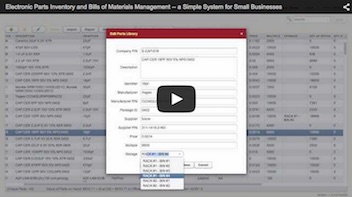When calculating the current stock level for a component, as required when planning upcoming builds, Parts-in-Place will first look up the latest Inventory document listing that particular part number. If an Inventory document with the required part is found, the system will use the quantity on that document as a reference point. If no inventory document listing the part is found, the calculation will start off with zero quantity.
Then the system will analyze the other documents (Parts Arrivals, Assemblies, Parts Write-offs) with effective dates later than the most recent inventory document listing the part in question. The system will basically “play back” the operations described by those documents, adjusting the calculated quantity in stock at each step.
Here’s an example. For the sake of simplicity, let’s consider a single component with the part number “P1”. Let’s assume the following documents have been entered into the system:
- Inventory 1, dated 2012-06-24. The quantity of P1 on this Inventory is 1000.
- Inventory 2, dated 2012-08-31. The quantity of P1 on this Inventory is 4000.
- Parts Arrival 1, dated 2012-07-28. The quantity of P1 on this Parts Arrival is 500.
- Parts Arrival 2, dated 2012-09-14. The quantity of P1 on this Parts Arrival is 2000.
- Assembly 1, dated 2012-07-01. The quantity per unit of P1 on this Assembly is 25, and the number of units assembled is 200.
- Assembly 2, dated 2012-09-10. The quantity per unit of P1 on this Assembly is 25, and the number of units assembled is 100.
Now, let’s assume that Parts-in-Place needs calculate the quantity of P1 in stock as of 2012-09-15. Here is what the system will do:
- It will look up the latest inventory document listing P1. In our example this will be the Inventory 2.
- Then, it will look for Parts Arrivals, Assemblies, and Parts Write-offs with the effective dates later than the date of the latest inventory found on step 1 above. In this example, the date on the latest inventory containing P1 is 2012-08-31, and so the system will then examine the Parts Arrival 2 and Assembly 2.
- The system will “play back” the operations described by those documents, adjusting the calculated quantity at each step:
- 2012-08-31. Based on the Inventory document, the quantity of P1 in stock is 4000.
- 2012-09-10. According to the Assembly document, 2500 pcs of P1 were used for a build. The remaining quantity in stock is 1500.
- 2012-09-14. According to the Parts Arrival document, 2000 pcs of P1 were received. As a result, the quantity of this part in stock rose to 3500.
So, in this example, Parts-in-Place will calculate the quantity of P1 in stock as of 2012-09-15 to be 3500.
Notice how the system simply ignored the Assembly 1 and Parts Arrival 1 documents in this scenario. There was no need to consider them, because there was an Inventory document from a later date listing the part that we were interested in.

25 units per board times 100 boards is 2,500 parts, not 250. I think your final tally is incorrect.
You are right, Ron! Thanks for the catch. I’ve corrected the post.